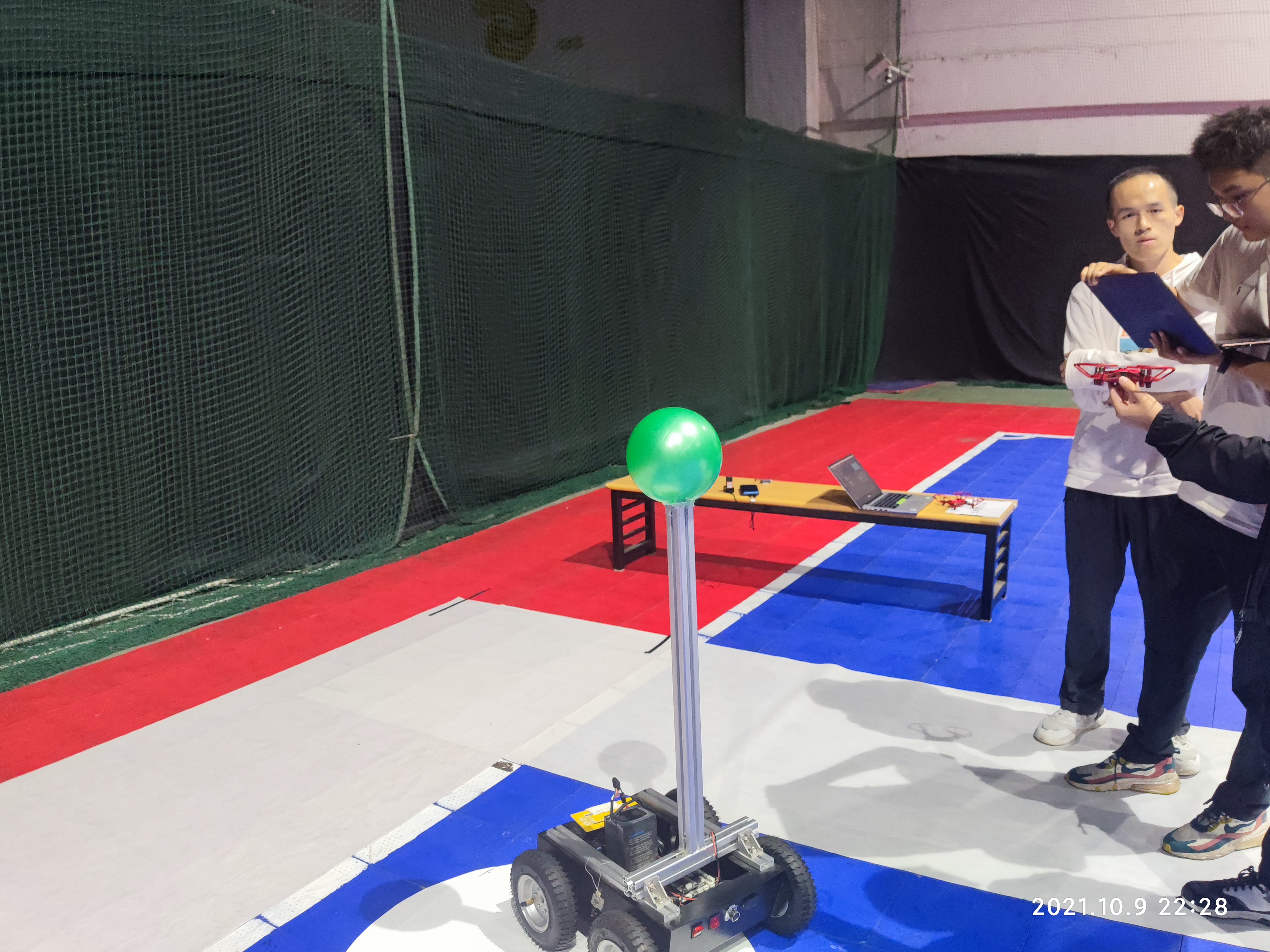1
2
3
4
5
6
7
8
9
10
11
12
13
14
15
16
17
18
19
20
21
22
23
24
25
26
27
28
29
30
31
32
33
34
35
36
37
38
39
40
41
42
43
44
45
46
47
48
49
50
51
52
53
54
55
56
57
58
59
60
61
62
63
64
65
66
67
68
69
70
71
72
73
74
75
76
77
78
79
80
81
82
83
84
85
86
87
88
89
90
91
92
93
94
95
96
97
98
99
100
101
102
103
104
105
106
107
108
109
110
111
112
113
114
115
116
117
118
119
120
121
122
123
124
125
126
127
128
129
130
131
132
133
134
135
136
137
138
139
140
141
142
143
144
145
146
147
148
149
150
151
152
153
154
155
156
157
158
159
160
161
162
163
164
165
166
167
168
169
170
171
172
173
174
175
176
177
178
179
180
181
182
183
184
185
186
187
188
189
190
191
192
193
194
195
196
197
198
199
200
201
202
203
204
205
206
207
208
209
210
211
212
213
|
import time
from robomaster import robot,battery
from robomaster import camera
import cv2
import numpy as np
import sys
sys.path.append(r'P:\Python\cv2')
from string_recognise_self import cv_show,FillHole,cv_drawContours,cv_center,cv_erodedAndDilated
"""碎片填充"""
def FillHole(img,SavePath='img_fillhole.jpg'):
img_in = img
img_floodfill = img_in.copy()
h, w = img_in.shape[:2]
mask = np.zeros((h+2, w+2), np.uint8)
isbreak = False
for i in range(img_floodfill.shape[0]):
for j in range(img_floodfill.shape[1]):
if(img_floodfill[i][j]==0):
seedPoint=(i,j)
isbreak = True
break
if(isbreak):
break
cv2.floodFill(img_floodfill, mask, seedPoint, 255);
img_floodfill_inv = cv2.bitwise_not(img_floodfill)
img_out = img_in | img_floodfill_inv
cv2.imwrite(SavePath, img_out)
return img_out
"""腐蚀与膨胀"""
def cv_erodedAndDilated(img):
size = 20
kernel = cv2.getStructuringElement(cv2.MORPH_RECT,(size,size))
eroded = cv2.erode(img, kernel)
img_dilated = cv2.dilate(eroded, kernel)
return img_dilated
"""小球位置识别"""
def cv_center(img):
kernel = cv2.getStructuringElement(cv2.MORPH_RECT,(5,5))
height,width,layer = img.shape
center_x = height/2
center_y = width/2
sensity = 10
green_lower = np.array([50-sensity,43,46])
green_upper = np.array([60+sensity,255,255])
hsv_frame = cv2.cvtColor(img, cv2.COLOR_BGR2HSV)
mask = cv2.inRange(hsv_frame, green_lower,green_upper)
mask2 = cv2.morphologyEx(mask, cv2.MORPH_OPEN, kernel)
mask3 = cv2.morphologyEx(mask2, cv2.MORPH_CLOSE, kernel)
mask4 = FillHole(mask3)
mask5 = cv_erodedAndDilated(mask4)
cnt,heridency = cv2.findContours(mask5,
cv2.RETR_EXTERNAL,
cv2.CHAIN_APPROX_SIMPLE)
if cnt == []:
continue
maxArea = 0
maxIndex = 0
for i, j in enumerate(cnt):
area = cv2.contourArea(j)
if area > maxArea:
maxArea = area
maxIndex = i
cv2.drawContours(img,cnt,maxIndex,(255,0,255),10)
x, y, w, h = cv2.boundingRect(np.array(cnt[maxIndex]))
cv2.rectangle(img, (x, y), (x+w, y+h), (0, 255, 0), 2)
size = 6000
area = w*h
robot_x = x+w/2
robot_y = y+h/2
left_sign = 0
right_sign = 0
forward_sign = 0
up_sign = 0
down_sign = 0
if area < size and area > size-2000:
forward_sign = 1
elif area > size-4000 and area <= size-2000:
forward_sign = 2
elif area <= size-4000 and size > 0:
forward_sign = 3
if area >= size and area < size+100000:
forward_sign = -1
elif area >= size+100000 and area < size+300000:
forward_sign = -2
elif area > size+300000:
forward_sign = -3
if robot_x < center_x and robot_x > center_x-120:
left_sign = 1
elif robot_x <= center_x-120 and robot_x >= center_x-240:
left_sign = 2
elif robot_x < center_x-240:
left_sign =3
if robot_x > center_x and robot_x < center_x+120:
right_sign = 1
elif robot_x >= center_x+120 and robot_x <= center_x+240:
right_sign = 2
elif robot_x > center_x+240:
right_sign =3
return forward_sign,left_sign,right_sign
if __name__ == '__main__':
tl_drone = robot.Drone()
tl_drone.initialize()
tl_flight = tl_drone.flight
tl_camera = tl_drone.camera
tl_battery = tl_drone.battery
print('battery=\t'+str(tl_battery.get_battery())+'%')
cnt = []
print(tl_drone.get_temp())
tl_flight.takeoff().wait_for_completed()
tl_camera.set_fps(fps='high')
tl_camera.set_bitrate(bitrate=6)
tl_camera.set_resolution(resolution='high')
tl_camera.start_video_stream(display=False)
try:
while True:
img = tl_camera.read_cv2_image(strategy='newest')
forward,left,right = cv_center(img)
"""
控制飞机遥控器的四个杆量
参数:
a – float:[-100, 100] 横滚
b – float:[-100, 100] 俯仰
c – float:[-100, 100] 油门
d – float:[-100, 100] 偏航
"""
a_level = [25,35,45]
b_level_forward = [15,25,40]
b_level_backward = [-30,-45,-60]
if forward == 1:
tl_flight.rc(b=b_level_forward[0])
elif forward == 2:
tl_flight.rc(b=b_level_forward[1])
elif forward == 3:
tl_flight.rc(b=b_level_forward[2])
elif forward == 0:
tl_flight.rc(b=0)
elif forward == -1:
tl_flight.rc(b=b_level_backward[0])
elif forward == -2:
tl_flight.rc(b=b_level_backward[1])
elif forward == -3:
tl_flight.rc(b=b_level_backward[2])
if left == 1:
tl_flight.rc(a=-a_level[0])
elif left == 2:
tl_flight.rc(a=-a_level[1])
elif left == 3:
tl_flight.rc(a=-a_level[2])
elif right == 1:
tl_flight.rc(a=a_level[0])
elif right == 2:
tl_flight.rc(a=a_level[1])
elif right == 3:
tl_flight.rc(a=a_level[2])
elif right == 0 and left == 0:
tl_flight.rc(a=0)
time.sleep(0.08)
cv2.namedWindow('Drone', 0)
cv2.imshow("Drone", img)
cv2.waitKey(10)
tl_flight.rc(a=0,b=0,c=0,d=0)
except KeyboardInterrupt:
pass
cv2.destroyAllWindows()
tl_camera.stop_video_stream()
tl_flight.land().wait_for_completed()
tl_drone.close()
|





